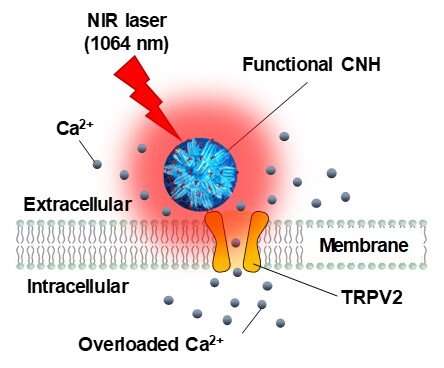Mechanism of cancer cell death triggered by photo-thermal property of CNH and temperature sensitive TRPV2-mediated Ca2+ overdosing. Credit: JAIST
The development of chemotherapeutic agents with selective anti-cancer activities is increasingly unattractive due to the emergence of resistance, poor targeting of cancer tissues, and subsequent metastasis. Among tumor characteristic cell types, cancer stem cells are increasingly associated with cancer progression and metastasis, reflecting self-renewal and their propensity to enter the circulation.
Scientists at Japan Advanced Institute of Science and Technology (JAIST) have created a regulation technology of fatal cancer stemness using the combination of nanotechnology and genetic engineering called as 'photothermogenetics' that allows for effective cancer elimination.
Developed by Associate Professor Eijiro Miyako and his team from JAIST, photo-active functional nanocarbon complexes, which made of polyethylene glycol (PEG)-modified carbon nanohorns (CNH) with an antibody against the receptor potential vanilloid family type 2 (TRPV2), showed high potential as a targeting cancer chemotherapeutic agent.
In fact, the nanocomplexes are effectively heated by biologically permeable near-infrared light. After application to cancer cells and mice tumor models, these complexes photo-thermally triggered calcium influx into target cells overexpressing TRPV2 (temperature-responsive membrane protein), resulting in increased cancer cell death and effective regulation of cancer stemness. The present experiments warrant further consideration of this novel chemotherapeutic approach using the best combination of nanotechnology and genetic engineering for the treatment of refractory cancers and control of fatal cancer stemness.
More information: Yue Yu et al, Photothermogenetic inhibition of cancer stemness by near-infrared-light-activatable nanocomplexes, Nature Communications (2020). DOI: 10.1038/s41467-020-17768-3
Journal information: Nature Communications
Provided by Japan Advanced Institute of Science and Technology
























